|

Description
Shape:
Standard, circular.
Blazon (Heraldic description)
Per fess wavy white and green; a greyhound courant, black .
CHASER: One that chases or pursues another. The green in the design references he grass greyhound racing track at the White City stadium, London, and the motto reflects the result of the contest.
For explanations of heraldic terms see the Badges & Honours page.
Motto:
VENANDO VICTOR
Victorious by chasing
|
|
Pennant Numbers:
D32 (Atlantic)
R306 /A727 (Pacific)
Battle Honours:
ATLANTIC 1943
ARCTIC 1944
OKINAWA 1945
|
|
|
Specifications
Builder:
Ingalls Shipbuilding
Corp, Pascagoula, Mississippi
Displacement: 14,170 tons
length (Overall): 486ft
Beam: 69ft 6in
Flight deck: 442ft x 80ft wood covered mild steel plate
Propulsion: 2 Foster Wheeler boilers; 1 x Allis-Chalmers
geared turbine driving 1 shaft
Speed: 18.5 knots
A/C Capacity: 20
Hangar: 262ft x 62ft x 18ft
A/C lifts: 2; aft 34ft long x 42ft wide; forward 42ft long x
34ft wide
Arrestor wires: 9 with 3 barriers
Catapult: 1 x H2 hydraulic
Armament: 2 single 4in USN Mk 9, 4 twin 40mm Bofors, 8 twin
20mm Oerlikon, 10 single 20mm Oerlikon
Crew Complement: 646
Commanding Officers:
Lt. Cdr. S. K.
Horn RN
May 42 - Jan 43
Capt. H.V P. McClintock RN
Feb 43 - Jan 45
Capt. R.G. Poole RN
Jan 45 - Jul 45
Cdr. M. N. Tufnell RN
Aug 45 -
May 46
Squadrons:
816
Feb-Mar 44
Swordfish II /
Wildcat V
835
Nov-Dec 43
Swordfish II & Sea Hurricane
845
May - Jun 43
Avenger I
899
Jan-Apr 45
Seafire L.III
Listen to this section


Click here to see more photos
|
| |
|
A History of HMS CHASER
|
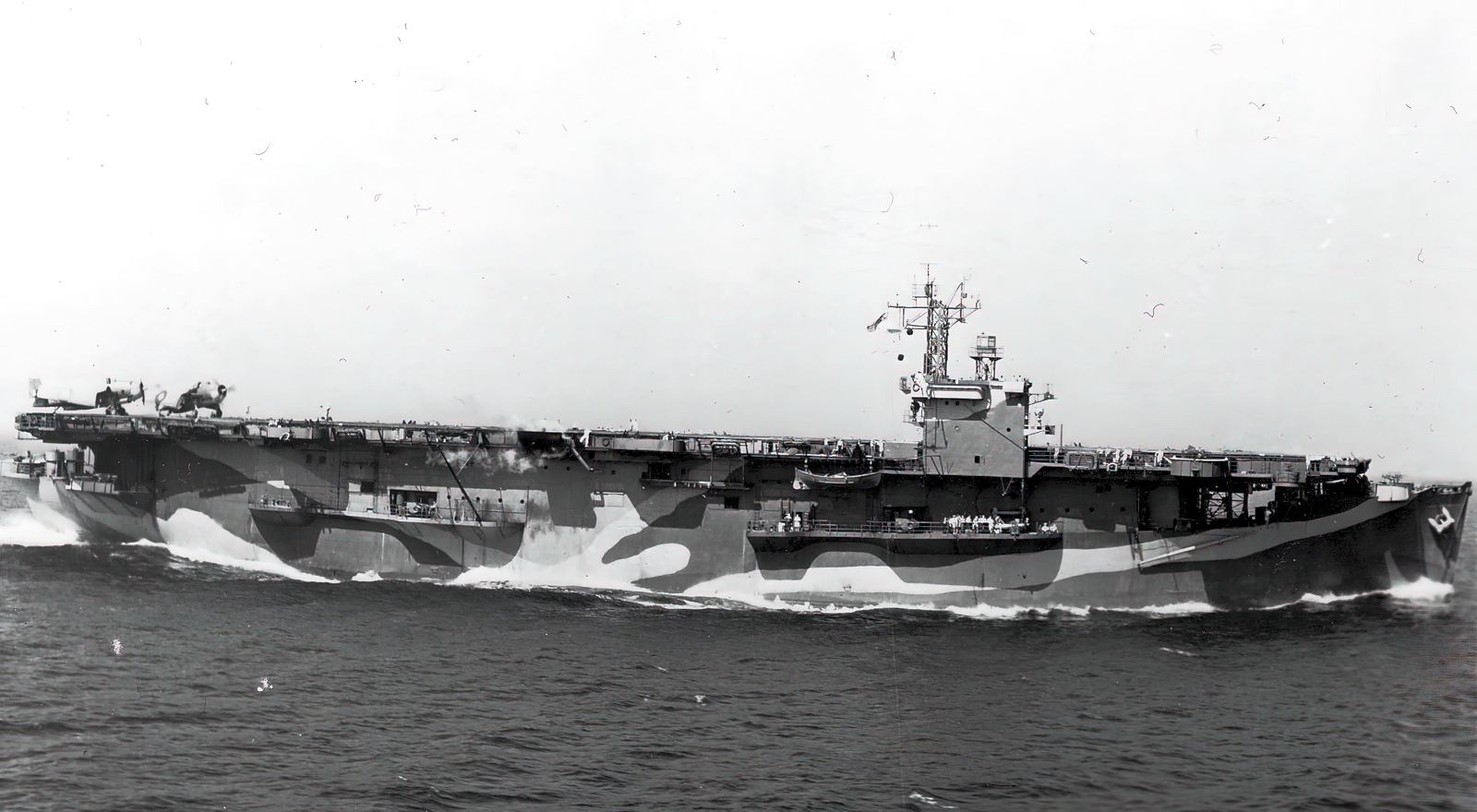 |
HMS CHASER underway in Chesapeake Bay with Avengers of 845 squadron embarked., June 1943. |
HMS CHASER began life as an 11,900 ton Maritime Commission C3-S-A2 type freighter, MORMACGULF ordered for the US operator Moore-McCormack Lines. Her keel was laid down June 28th 1941 at the Ingalls Shipbuilding Corporation shipyard, Pascagoula, Mississippi, she was Maritime Commission hull number 162, Ingalls hull number 295. On December 26th 1941 the MORMACGULF was purchased by the US navy for conversion an auxiliary aircraft carrier the USS BRETON, AVG – 10. She was launched June 19th 1942. By her sponsor Mrs. Eugene T. Oates.
TThe name BRETON was cancelled when it was decided that AVG - 10 was to be transferred to the Admiralty under the lend-lease programme on completion. AVG-10 began her contractor’s trials at the beginning of April 1943 and work was completed on April 9th when the ship was formally delivered to the U.S. Navy. She was transferred to the Royal Navy the same day and commissioned as HMS CHASER, Captain H.V.P. McClintock DSO, RN in command. She was the second vessel to bear this name, the first was a 320 ton, 18 gun Sloop, in 1781.
Sea trials and work-up: April to June 1943
Having completed her Admiralty acceptance trials CHASER was ready to sail on her maiden voyage: on the morning of April 16th CHASER departed Pascagoula at 07:30 for Mobile, arriving at 10:30 that day, \Continuing on to Norfolk Navy Yard, arriving there on the 23rd. Three days later she entered dry-dock and work commenced to complete the installation of radio direction finder equipment, pitometer log and dead reckoning tracer system. Her radar mast was strengthened. Installed excluding deadlights and alterations to her paravane stowage. On the 27th she was visited by Sir Ronald Ian Campbell, deputy head of the British mission at Washington, D.C., who inspected the Carrier and the Battleship QUEEN ELIZABETH which was also in the Navy Yard.
She emerged from the dockyard on May 14th and sailed to begin working up to operational efficiency in the Chesapeake Bay area. This was completed by May 21st when the carrier prepared to receive her first operational aircraft. CHASER was to embark and operate the 12 Avenger Mk.1s of 845 Naval Air Squadron on passage to the UK; this squadron had been formed and trained at USNAS
Quonset Point
and had moved to USNAS
Norfolk by May 27th for Deck Landing Training aboard both the USS
CHARGER (on the 27th) and CHASER (from 28th May) in Chesapeake Bay. There were two deck landing accidents on the first day of flying operations form CHASER, both aircraft suffered minor damage FN777 flown by Lt. W. H. Johnstone, RNVR hit an obstruction on the flight deck, while FN781 flown by Sub-Lt K. M. Burrenston, RNVR drifted on landing and a wheel slipped of the edge of the deck into the catwalk. The ship returned to her berth alongside pier #7 at 19:30 on the 29th, sailing again at 12:45 on the 31st to embark 845 squadron on the June 1st.
More defects appeared over the next 6 days and she returned to Norfolk on June 6th to have them addressed mooring alongside at Pier #7 at mid-day. Dockyard workers repaired auxiliary motors, generators, a diesel oil transfer pump motor, diesel oil purifier motors, lubricating oil purifier motor, two fire pump motors, generator switchboard, a drain line and whistle pipe. She put to sea again at 09:99 the following morning to complete her work-up. She arrived back at the Norfolk Navy Yard at 07.40 on the 9th. The following day she called at the US Naval Ammunition Depot, St. Juliens Creek, Virginia, to embark small arms and gun ammunition before sailing again at 06:50 on the 14th for gunnery exercises, returning to her berth at pier #7 at 17:15 on the 18th.
Passage to the UK and under repair: June - October 1943
Repairs, and work up complete CHASER departed for New York, smiling at 08:10 on June 20th. On the 23rd she joined Convoy HX245, bound for the Clyde, 845 squadron conducted anti-submarine patrols as part of the convoy escort. The convoy crossing was without incident and CHASER arrived on the Clyde on July 4th; 845 squadron left the ship disembarking to
RNAS Machrihanish.
On July 17th CHASER suffered serious damage when an explosion occurred in the boiler room; there were no serious injuries but the ship required dockyard assistance to effect repairs. There was no room in any of the Clyde yards so CHASER took passage to Rosyth for repair in the Naval Dockyard. The repairs were to take three months, CHASER arrived back on the Clyde on October 29th.
Working up with 835 squadron: November 1943
She was now allocated to Western Approaches Command and embarked the maintenance personnel of 835 squadron, in preparation for beginning a work up in the Clyde training areas. The squadrons 9 Swordfish and 6 Sea Hurricanes flew out from
RNAS Eglinton,
Northern Ireland on November 6th.
Flying operations during the work up resulted in four damaged aircraft; on the 25th Sub-Lt C. J. Allen, RNZNVR in Sea Hurricane BW886 came in for a fast landing, bounced and stalled, finally stopping wham it's starboard oleo collapsed. The following day saw two Swordfish damaged, when Sub-Lt E. H. McCown, RNVR in LS243 collided with HS612 while taxying on the flight deck. On the 28th, the last day of flying Sub-Lt J. P. Supple, RNVR in Swordfish LS457 suffered a deck landing accident. Her work up program complete 835 departed for
RNAS Eglinton and CHASER returned to the Clyde for a further period of defect rectification in a commercial shipyard on November 29th.
Her repairs were to take until early January 1944 to complete; she was at sea for a post repair shake-down when Seafire MB141 of 778 service trials Unit, testing her flight deck equipment crashed in the Clyde estuary on the 14th killing the pilot Lt. K. J. Robertson.
|
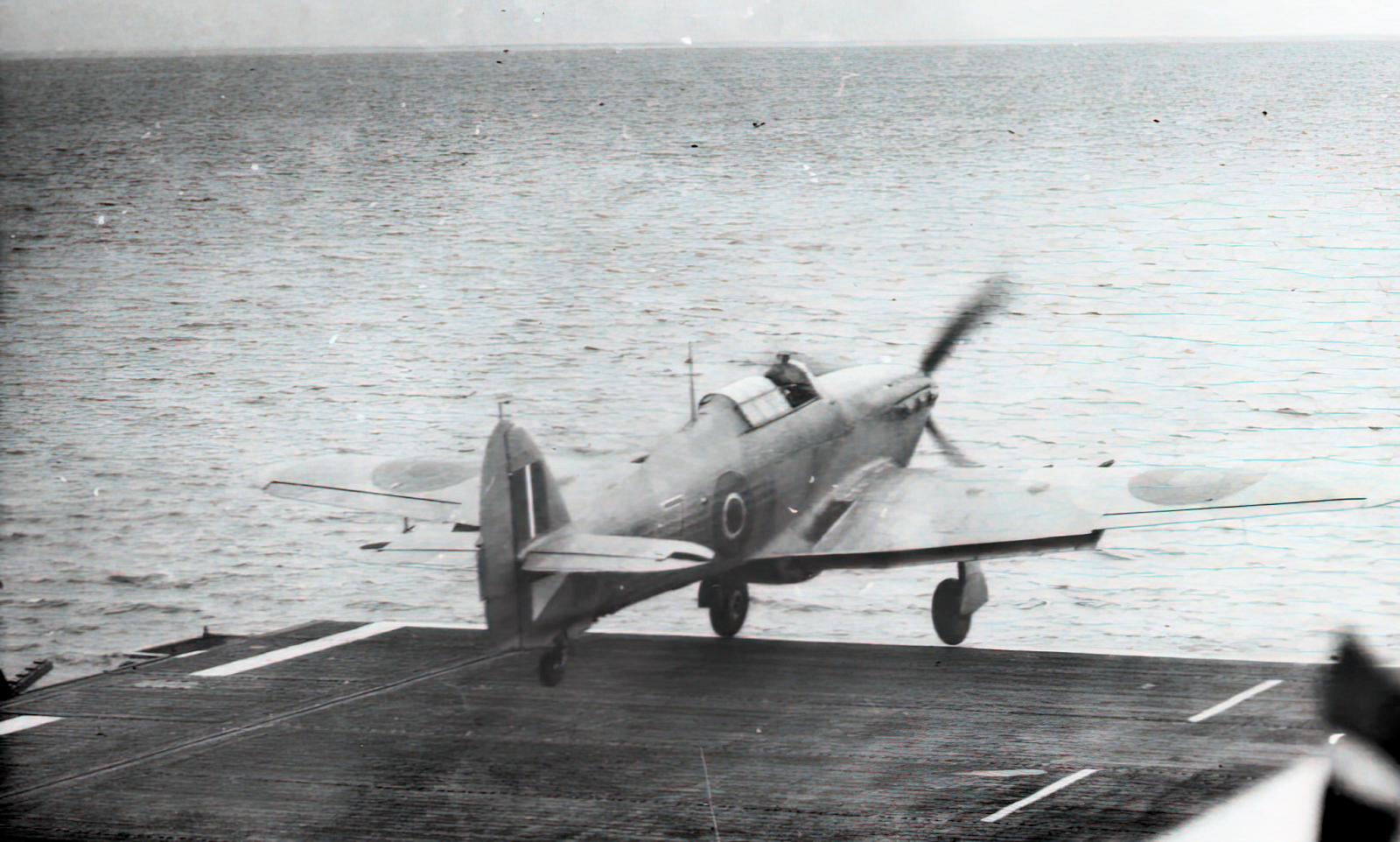
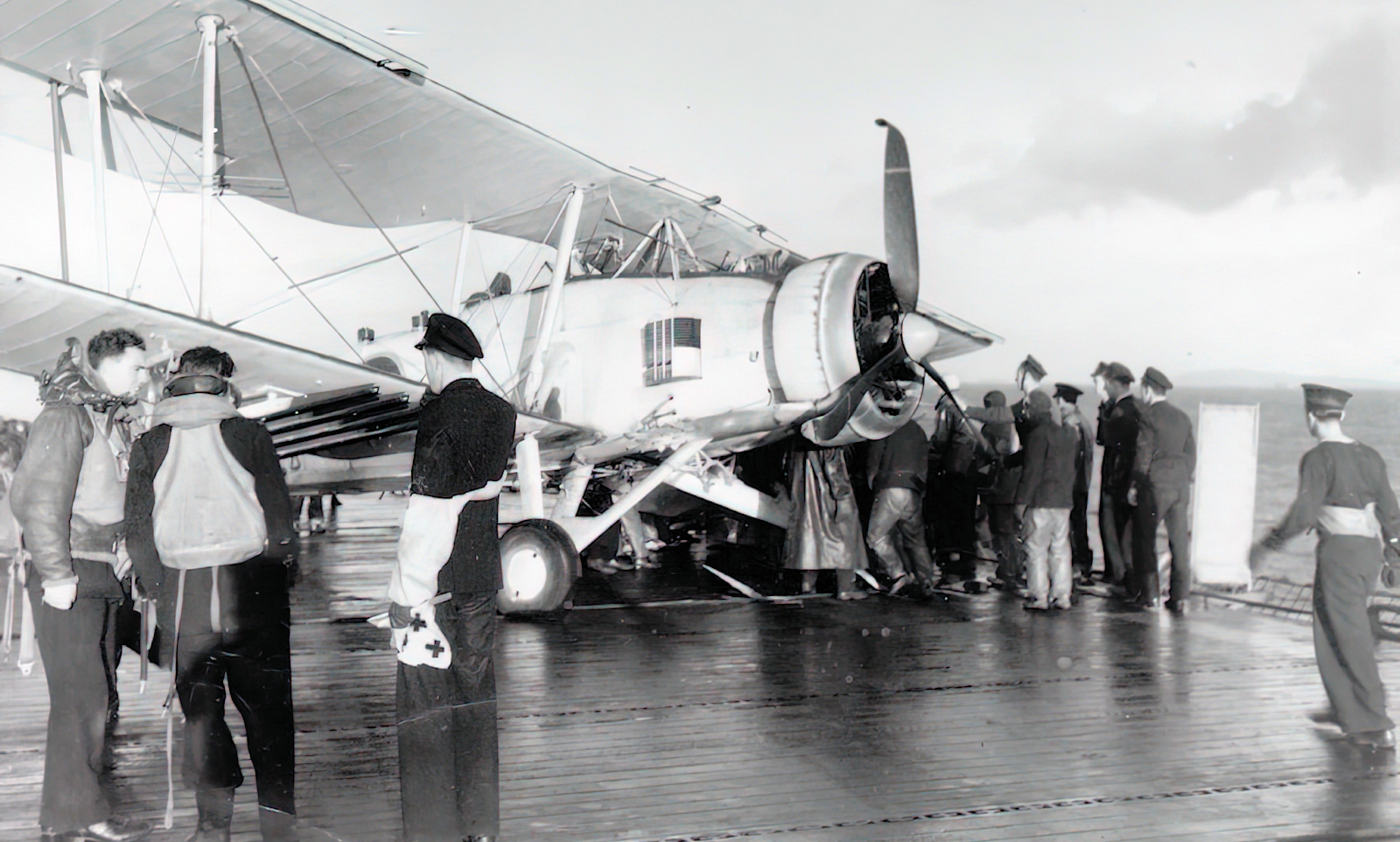 |
Left: Sea Hurricane Mk. Ilc of 835 Squadron takes off in the Irish Sea c. November 1943. Right: Swordfish LS272 of 835 Squadron after suffering a port undercarriage collapse on landing c. Dec 1943. Images courtesy of Steve Moss
|
816 squadron and Russian convoy escort duty: January - March 1944
On returning to active duty CHASER was allocated to trade protection duties on the Russian convoy route. She embarked the aircraft and personnel of 816 squadron, 9 Swordfish and 5 Wildcat, from
RNAS Donibristle on January 19th.
She sailed from the Clyde for exercises and passage to Scapa Flow on February 5th. On February 9th she took part in A/S (anti-Submarine) exercises off Larne with the Submarine HMS VOX and the Armed Yacht HMS PHILANTE, as well as ships from the 3rd Escort Group. She arrival at Scapa on the 10th and on completion of exercises the aircraft of 816 were put ashore to RNAS Hatston on February 12th but re-embarked the 16th. CHASER was now allocated as part of the covering force for Operation FX, the passage of Russian convoys JW.57 outbound and RA.57 homebound.
JW.57 (43 ships and 6 Russian light craft) sailed from Loch Ewe on February 20th escorted by the Destroyers KEPPEL, BOADICEA, BEAGLE, WALKER, Corvettes BLUEBELL, CAMELLIA, LOTUS, and RHODODENDRON (Western Approaches) with local escort of Corvettes BURDOCK and DIANELLA (Western Approaches), Minesweepers RATTLESNAKE, ORESTES, LOYALTY, and HYDRA. CHASER in company with the Cruiser BLACK PRINCE (Vice Admiral Sir Irvine Glennie, KCB, CB (VA Destroyers)), Destroyers VERULAM, and VIGILANT left Scapa to join the convoy on the 21st, joining the convoy on the 22nd. They were joined by another group of Destroyers, MILNE (Captain D3), MAHRATTA, MATCHLESS, METEOR, OBEDIENT, OFFA, ONSLAUGHT, ORIBI, SAVAGE, SERAPIS, SWIFT, VERULAM and VIGILANT which relieved the local escort.
CHASER began Swordfish A/S patrols on joining the convoy which was detected on the 23rd by a Ju88 maritime reconnaissance bomber. This was then relieved by an Fw200 Condor long-range maritime reconnaissance aircraft which shadow them for the rest of the day. It was back the next day and Wildcats were launched to intercept but no contact was made. By now a number of U-Boats were getting into position to attack the convoy. At 20.55 on the 25th the first successful U-Boat attack resulted in the sinking of the Destroyer MAHRATTA by U-990 in position 71°12' N, 13°30' E, she exploded and sank within minutes killing 220 with 16 survivors. Further U-Boat attacks were made on the 26th and 27th but none were successful. On the 28th the convoy split into two sections – White Sea section (10 ships) proceeded with local escort (2 Russian destroyers and 4 Russian minesweepers), while the Murmansk section (33 ships and 6 Soviet Light Craft) arrived Kola Inlet. The weather had been bad for most of the passge and no U-Boats had been sighted by the Swordfish patrols. Despite the conditions there was only one flying accident on the 26th when Swordfish HS678 piloted by Sub-Lt F. H. Borlace, RNVR lost his undercarriage making a low approach to the deck in snowstorm and belly landed, the aircraft was write off but he crew were OK.
RA.57, the return convoy comprising of 31 unlade ships sailed from the Kola Inlet on March 2nd, CHASER began A/S patrols once clear of the coast. The convoy was located by German air reconnaissance on March 4th. Not long after departure, in position 73°25' N, 22°11' E the merchantman EMPIRE TOURIST was hit by a torpedo fired by U-703 and sank. Later that afternoon she attempted another attack but was detected by the Destroyer MILNE which attacked with depth charges for several hours before the boat escaped. A flight of two Wildcat fighters was launched to intercept a Bv138 Maritime patrol flying boat; Lt. B. H. Beeston, RNVR in JV490 ('U') and Sub-Lt. F. P Bethel, RNVR in JV419 ('T') successfully shot it down.
A Swordfish shared in the successful destruction of a U-Bot on this date; HS641 ('B') and the Destroyer ONSLAUGHT engaged U472 in position 73°05' N 26°40' E, twenty-seven miles from the convoy. The Swordfish made rocket attacks while ONSLAUGHT engaged with her guns; the Swordfish crew Sub-Lt P. J. Beresford, RNVR & Sub-Lt W. F. Laing, RNVR were both awarded the DSC; Leading Airman J. Beech was awarded the DSM for this action.
On the 5th 816 scored its first outright kill; Swordfish NF135 ('F') attacked U-366 with rocket salvoes and sank her in position 71°10' N 14°45' E. The Swordfish crew Sub-Lt J. F. Mason, RNVR and Sub-Lt D. Street, RNVR were both awarded the DSC; Leading Airman D. G. Franklin was awarded the DSM for this action.
On March 6th Swordfish NE865 ('X') was involved in two attacks against U-Boats; The crew surprised and attacked U-703 on the surface, the aircraft used patchy clouds to stalk it but came under fire from quadruple and two twin 20mm AA guns just as it started to dive. She strafed the U-boat and fired eight rockets in four salvoes; one rocket was seen to ricochet over the top of the conning tower after it struck the railing. The Swordfish was forced to remain at distance by very accurate fire until the U-boat was again able to escape by crash diving after sustaining only minor damage. During the second attack they sank U-973 in position 70°04' N 05°48' E with rocket salvos; the crew Sub-Lt L E. B. Bennett, RNVR and Sub-Lt E. W. Horsfield, RNVR were both awarded the DSC; Petty Officer Airman C. A. Vines was awarded the DSM. Also on the 6th there was a serious landing accident when Swordfish LS156 piloted by Lt. F. C. Nottingham, SANF entered the barrier badly damaging Wildcat JV365 parked forward; both aircraft were damaged beyond repair. There was one further landing accident on the 7th, Swordfish HS646 piloted by Sub-Lt R. F. Creighton, RNVR had its starboard oleo torn out of the fuselage.
CHASER, escorted by OBEDIENT, OFFA, and ONSLAUGHT detached from the convoy on the 8th and proceeded to Scapa, arriving on the 9th.
Grounded, under repair and Ferry Carrier conversion: March - ? 1944
Four days after her return to Scapa she dragged her anchor on the 13th and grounded in severe weather. She was towed clear the next day and the damage was assessed; she would need a dockyard to make the necessary repairs and she left Scapa for Rosyth under tow on the 17th. On arrival at Rosyth on the 18th preparations were made for 816 squadron aircraft to be put ashore and towed to RNAS Donibristle before she entered the dockyard. On completion of her repairs ache sailed to Belfast to be converted to a ferry carrier. It is unclear when she emerged from the conversion, possibly as late as December 1944.
Reallocated to the British Pacific Fleet
CHASER emerged wearing the Admiralty ‘standard’ camouflage pattern and wearing her pennant number ‘32’. She is recorded as arriving at Scapa on January 19th 1945 to carry out radar calibrations. She sailed for the Clyde on the 22nd, arriving on the 23rd. She now briefly embarked the Seafires of 899 squadron from RAF Log Kesh on the 25th for a short period of flying training; they flew ashore to RNAS Belfast on the 29th.
On February 2nd she was officially allocated to the British Pacific Fleet (BPF) for duty as a replenishment carrier. She now began making preparations for a voyage to Sydney, Australia, via Cochin and Trincomalee. 899 squadron, intended as a Seafire Pool Squadron for the BPF re-embarked from
RNAS Belfast
on the 25th, and flying training continued. There were several flying accidents, three barrier crashes occurring before the ship sailed for Australia; on March 1st Sub-Lt DH Grime, RNVR in NF519, on the 4th Sub-Lt R. A. Gorvin, RNVR in NM998, and Sub-Lt T. P. Hawker, RNVR in NF546 crashed on the 7th. Just prior to sailing Sub-Lt B. A. Gentry, RNVR damaged the prop of NM 997 on the 9th.
CHASER sailed as part of convoy KMF.41 for the first part of her voyage, departing from the Clyde on March 10th, arriving at Gibraltar on the 17th. It is unclear if flying continued on passage to Gibraltar, but did continue during passage through the Mediterranean to Port Said. On March 21st Sub-Lt J .M. Sturrock, RNVR in NF544 floated over wires and his starboard wingtip hit the island. Sub-Lt D. T. Challick RNethN wrote off his, unidentified, Seafire in a barrier crash on 20th .
After passing through the Suez Canal and calling at Aden she arrival at Cochin in Southern India, here the Seafires of 899 were stowed in the hangar and she embarked a mix of Avenger, Corsair, Hellcat and Seafires as deck cargo, many in a state of preservation, some packed in carats for delivery to Australia.
It is unclear whether CHASER disembarked her
ferry load at Sydney (RNAS Bankstown) or Brisbane (RNAMY Archerfield) on
arrival in Australia; on April 23rd she disembarked the Seafires of 899 to
RNAS Schofields, New South Wales.
Operations with 30 ACS and the Air Train
On her arrival at Sydney work began to prepare the ship to join the 30th Aircraft Carrier Squadron (30 ACS), at that time the squadron comprised of the CVEs
RULER,
SLINGER,
SPEAKER, and
STRIKER under the command of Commodore Carne in
STRIKER), her pennant number was changed to R306 for operations in the Pacific theatre. 30 ACS formed part of the ‘Air Train’, the aviation logistic support element of the British pacific Fleet’s logistics life-line ‘the Fleet Train’; this was a collection of merchant and military vessels which supplied the BPF with fuel, food, armaments and other stores. Based in Sydney, with forward bases at Manus in the Admiralty Islands and Leyte in the Philippines, the Fleet Train operated over a distance of some 2,500 miles each way.
|
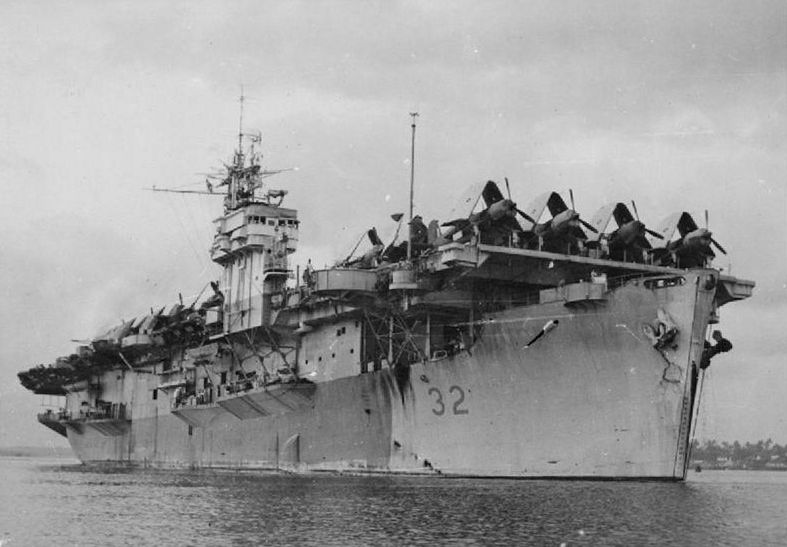
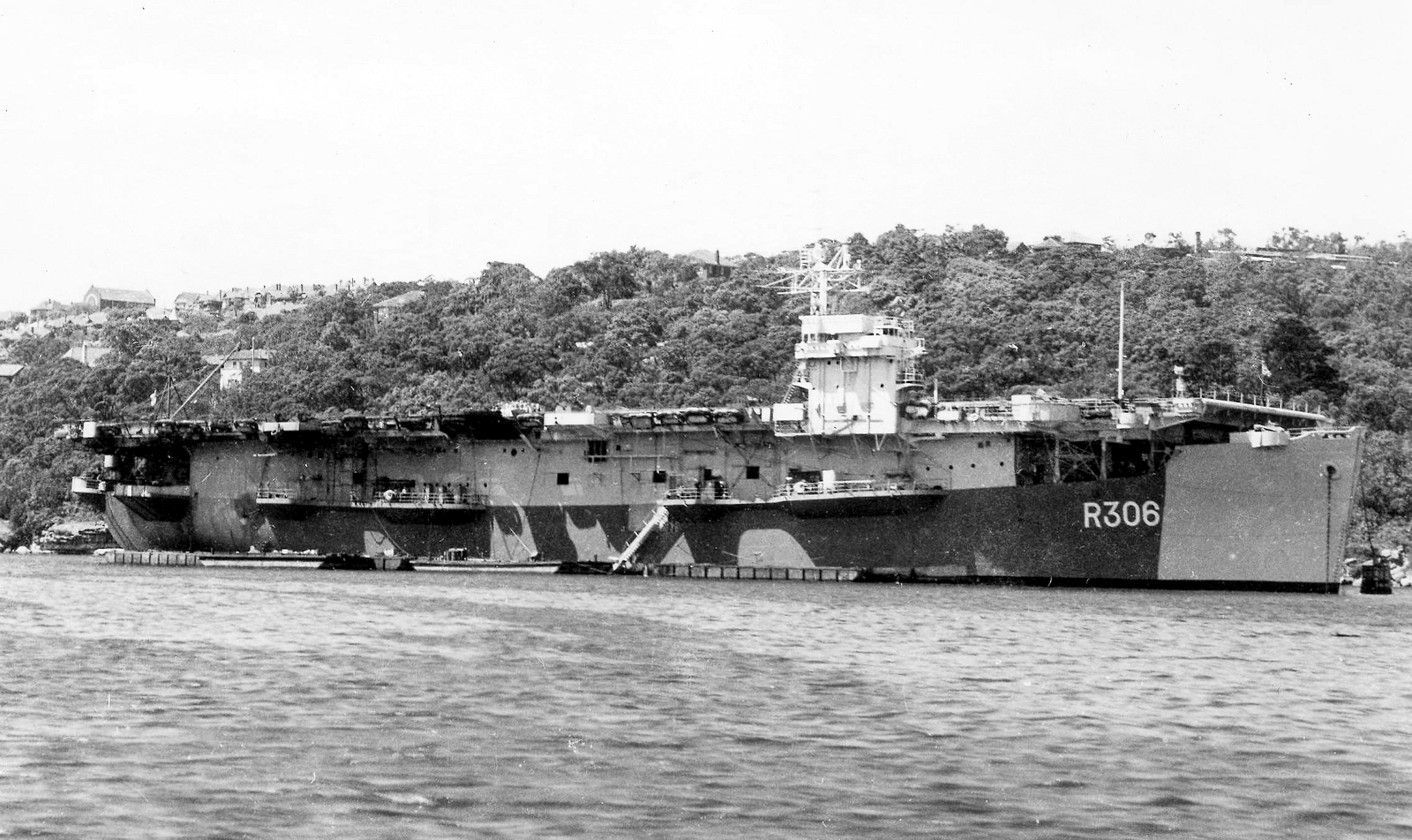 |
Left: CHASER at Cochin with a ferry load of aircraft embarked for delivery to Australia. Right: CHASER anchored in Little Sirius Cove, Sydney wearing her BPF pennant 'R306' ready to sail for Manus |
It had been decided that in addition to her role as a ferry and replenishment carrier CHASER was to embark half of Maintenance, Storage & Reserve Unit No.5 (M.S.R.5), which had been split into 'A' & 'B' units, to service and maintain a stock of spare aircraft as part of the Forward Aircraft Poll (F.A.P.) afloat. The other half was embarked in the CVE
ARBITER on May 15th with the same purpose
*.
On sailing from Sydney CHASER acted as a ferry carrier and was loaded with spare aircraft for delivery to the Forward bases at Manus and Leyte. She arrived at Manus on May 2nd and sailed for Leyte the following day; on arrival on station at Leyte her ferry load was transferred to the Aircraft maintenance Carrier
UNICORN and a replenishment load embarked.
The British Pacific Fleet, had left Sydney on February 28th 1945 and joined Admiral Raymond Spruance's United States Fifth Fleet on March 15th, being redesignated Task Force 57 (TF 57) on this date. They began offensive operations on March 27th as part of operation ICEBERG, the invasion of Okinawa. The British Carrier Force was tasked with denying the Japanese use of airfields on two Islands in the Sakishima-Gunto group, a group of islands located at the southernmost end of the Japanese Archipelago, located between the southern border of the East China Sea and north western border of the Philippine Sea. TF 57 was to conduct a series of 12 strike days in rotating cycles of 2 days of strikes and 2 – 3 days of replenishment; when TF 57 stood down to replenish the strike task was taken over by elements of US TF 58 and later TF 52. At the time of CHASER’s arrival on station the second phase of ICEBERG operation was underway, ICEBERG Two.
CHASER was to be employed as a forward area replenishment carrier carry replenishment loads of spare airframes for issue to Fleet Carriers whilst at sea. The replenishment carriers embarked mixed loads for transport to the replenishment area, numbers varied from 14 - 25 aircraft. The replenishment loads for ICEBERG Two were adjusted due to an acute shortage of Seafires; the average load for ICEBERG Two was 3 Seafires, 1 Avenger, 10 Corsairs, 7 Hellcat, and 1 Firefly, this was due to a shortage in Seafires being assembled and sent forward from Australia (loads for ICEBERG One loads were typically 9 Seafires, 7 Avengers, 6 Corsairs, 1 Hellcat, and 1 Firefly).
First replenishment
period: CHASER sailed from Leyte on May 14th to join the Logistic
Support Group (LSG) in the replenishment area Cootie at approximate position
21° 12’ N 128° 44’ E. At 05:45 on May 18th the BPF Carrier Strike Force
(FORMIDABLE, INDEFATIGABLE, INDOMITABLE, and VICTORIOUS) Met with the LSG
(tankers CEDARDALE, SAN AMBROSIO and SAN ADOLPHO, with the CVE
RULER (885 Sqn for Combat Air Patrols (CAP) & Anti-Submarine Patrols
(ASP)), Sloop CRANE, Destroyer s GRENVILLE, NORMAN, WHIMBREL, Frigate
PARRETT, Australian Minesweeper BENDIGO, and the Tug WEASEL).
At 10:30 a serious fire
broke out in FORMIDABLE; the guns of a Corsair in the hangar were
accidentally fired into the Avenger parked in front, this exploded starting
the fire. It became clear right away that the fire curtains which should
have automatically partitioned the hangar were out of action due to earlier
Kamikaze attacks. The fire was eventually extinguished by drenching the
hangar with sea water; 7 Avengers and 21 Corsairs were damaged, ranging from
complete write-offs to flyable duds. By the evening she reported being able
to resume limited flying operations. CHASER had transferred 3 Seafires, 2
Hellcats, 1 Firefly, 2 Avengers and 1 Corsair. At dusk TF 57 withdrew for
the night.
On the second day of
replenishment the Ammunition Carrier ROBERT MAERSK joined the Logistic
Support Group and CHASER recovered 3 flyable, but unserviceable, Avengers
and 1 Firefly. On completion of replenishment TF 57 departed for the
operational area to carry out their 11th series of strikes against the
airfields of the Sakishima Gunto Islands.
Second replenishment
period: On the morning of May 22nd TF 57 net with the LSG in area Cootie
(1) at approximate position 21° 12' N 128° 44' E for the last full
replenishment period of the ICEBERG operations. Now comprising of the
Tankers AASE MAERSK, SAN AMADO, WAVE KING and WAVE MONARCH,
RULER (885 Sqn for CAP & ASP), Armament Store ship ROBERT MAERSK,
Cruiser BLACK PRINCE, Sloop CRANE, Destroyers FINDHORN, GRENVILLE, NAPIER,
NORMAN, QUILLAM, Frigate AVON, and the Tug WEASEL. CHASER had been joined by
SPEAKER since the last replenishment o there were now two replenishment
carriers on station.
During the day CHASER
transferred 10 aircraft to the Fleet,
SPEAKER issued 1 Avenger to 849 squadron on VICTORIOUS. At 18:00
FORMIDABLE was detached to proceed to Manus and then onward to Sydney to
expedite repair of her battle damage. She was escorted by KEMPENFELT and
WHIRLWIND, both of whom were due for refit. At 19:15 the Fleet disengaged
from the Tanker Group for the night. Replenishment continued on the 23rd;
SPEAKER issued 3 Fireflies to 1770 squadron on INDEFATIGABLE and CHASER
transferred 4 more aircraft. During the day 2 Hellcats from CHASER crashed
into the sea: neither pilot was recovered. At 18:00 CHASER,
SPEAKER and NAPIER were detached for Manus, leaving
RULER with the Tanker Group. At 18:15 the Fleet, now operating only 3
carriers, detached from the Tanker Group taking departure for the operations
area for one final strike period. CHASER and
SPEAKER arrived at Manus on May 29th, CHASER sailed for Sydney on June
1st.
Support of operations again the Japanese mainland
After nearly a month in port making repairs and storing, he ships of the BPF (now transferred from the US Fifth Fleet to operate as part of Admiral William Halsey's United States Third Fleet and now designated TF 37), and elements of the Fleet Train (TF 112), sailed from Sydney on June 28th to return to Manus. TF 37 arrived at Manus on July 4th and after refuelling sailed from Manus for the forward area on July 6th to rendezvous with US Navy's Fast Carrier Force TF 38 on July 16th to begin joint operations against the Japanese mainland.
CHASER arrived at Manus on July 16th carrying a ferry load of airframes for delivery to RNAS Ponam. After unloading she embarked her replenishment load; a typical load for this operation was a mix of 24 aircraft 9 Seafires, 7 Avengers, 6 Corsairs, 1 Hellcat and 1 Firefly, however Corsair loses were higher than projected so extra Corsairs were carried.
The Logistic Support Group was no longer operating out of Leyte, the Replenishment carriers sailed from Manus to the new replenishment areas, now much further north off the Japanese mainland, a round trip of approximately 4,500 miles. Fleet Train aviation support was now centred on US Naval Air Station
Pityilu, 22 miles south of
RNAS Ponam in the Admiralty Islands; The Maintenance Carriers
PIONEER, flying the broad pennant of the Commodore Air Train (COMAT) and
UNICORN , Aircraft Component Repair Ship
DEER SOUND and the two Air Store Issue Ships
FORT COLVILLE and
FORT LANGLEY anchored off Pityilu. A permanent Forward Aircraft Pool had been established ashore here delivered by
PIONEER in late June, this relieved the need to ARBITER and CHASER to maintain an excess stock of reserve airframes on-board. The Tanker force now used Eniwetok Atoll as their base.
Because of the additional distance to be covered the replenishment carriers operated in pairs for this round of operations, air cover was provided by
RULER.
STRIKER and
ARBITER were on station for the first replenishment periods on July 20th. On completion of replenishment on the 223rd
ARBITER withdrew and proceeded to Manus to resupply. Her place was taken by
SPEAKER on the 26th,
STRIKER sailing for Manus on completion of her second replenishment.
CHASER sailed from Manus on the 24th and joined SPEAKER for the third replenishment July 31 – August 2nd. TF 37 met with the Tanker Group OLNA, CARELIA, WAVE GOVERNOR and WAVE KING in
replenishment area ‘British Tizzy’ approximate position 28° 4’ N 139° 00’ E, and oiling began at 10:00. The LSG comprised of
RULER (CAP & ASP),
SPEAKER and CHASER (Replenishment), the VSIS GLENARTNEY, ASIS ROBERT MAERSK and CORINDA, and the Radio and Radar Repair Ship
ARBUTUS. They were escorted by destroyers NORMAN and QUEENBOROUGH, sloops CRANE, PHEASANT, WOODCOCK and REDPOLE, frigates ODZANI and DERG and minesweeper PIRIE. Fuelling continued through the day and replacement aircraft and pilots were transferred to the carriers. TF 37 disengaged at 18:50 for the night and changed course to the south to avoid the tail of a typhoon due to pass to their north.
Fuelling resumed at 05:20 on August 1st in approximate position 27° 15’ N 138° 00’ E. Oiling was hampered by a heavy swell and the typhoon still threatened the ships of TF 37 and TF 38; the US commander ordered a further move south at the end of the day’s replenishment, to rendezvous in area ‘HURRICANE’ at position 25° N, 137° E. On the morning of August 2nd storing and ammunitioning continued, oiling was now down to two tankers, two had to depart in order to reload and be back on station for the next replenishment period. The LSG and the Tanker Group detached at 16:50 to proceed to the next replenishment area at 34° 20’ N, 147° E. During this replenishment CHASER issued 3 Corsairs, 2 of them to 2 CAG, FORMIDABLE. And 1 to I CAG VICTORIOUS.
SPEAKER Saied for Manus on completion.
While TF 37 conducted air strikes the LSG set course for the next replenishment area due to commence on August 6th. The new replenishment area was to be at position 33° 36’ N, 147° E, not were previously organised so the Tanker Group and LSG were redirected to the new rendezvous. The LSG now comprised of the Tankers OLNA, WAVE KING, DINGLEDALE, SAN AMADO, with
RULER (CAP & ASP),
ARBITER had arrived from Manus to join CHASER (Replenishment), VSIS FORT WRANGELL and GLENARTNEY, and repair ship
ARBUTUS. They were escorted by destroyers NORMAN and NIZAM, sloops CRANE, PHEASANT, WOODCOCK and REDPOLE, frigates BARLE and DERG, RAN minesweepers
BALLARAT and
BURNIE. Unbeknown to the men of TF 37 the first atomic bomb had been dropped on the Japanese city of Hiroshima at 08:15.
ARBITER issued 10 Seafire, 6 Corsairs, 1 Avenger and 1 Firefly; she received 3 'flyable duds', 1 Avenger and 2 Seafires. CHASER issued 1 Seafire.
On the 7th
ARBITER and CHASER operated as auxiliary Oilers fuelling vessel of TF 37. All oiling was completed by 11:30. The Fleet set course for the flying off position. On completion CHASER transferred all remaining serviceable aircraft to
ARBITER and she departed for Manus, arriving at Ponam Island on August 12th to unload aircraft.
Japan surrenders; post war employment It was intended that she should remain at Ponam to do Deck Landing Training with the reserve first-line crews, but she was required for another commitment and this had to be cancelled. By this time the news of Japan's announced willingness to accept the Allies surrender terms had been received and projected plans were put on hold. CHASER moved to a mooring in Seeadler harbour on the 14th.
On August 15th the Japanese surrender was announced and J-J Day was celebrated anchored in Seeadler harbour, Manus. She appears to have remained at her mooring until the 23rd when she put to sea, destination unknown. At some stage in late August Commander. M. N. Tufnell RN relieved Captain Poole as commanding officer. CHASER arrived back at Manus on the 27th, only to sail for Sydney on the 30th.
It is unclear what duties CHASER performed on arrival back in Australia, but she undertook a short period of defect rectification in Sydney starting on October 3rd. On completion she sailed for Manus, arriving there on the 29th. She arrived off Ponam Island at 17.30 to embark equipment as part of the evacuation on MONAB IV from
RNAS Ponam, including aircraft, two refrigerators and Mobile Malaria Hygiene Unit (M.M.H.U.) 5 for ferrying to Australia. At 05:30 on the 31st she moved to a marring in Seeadler Harbour, sailing for Australia on November 1st.
|
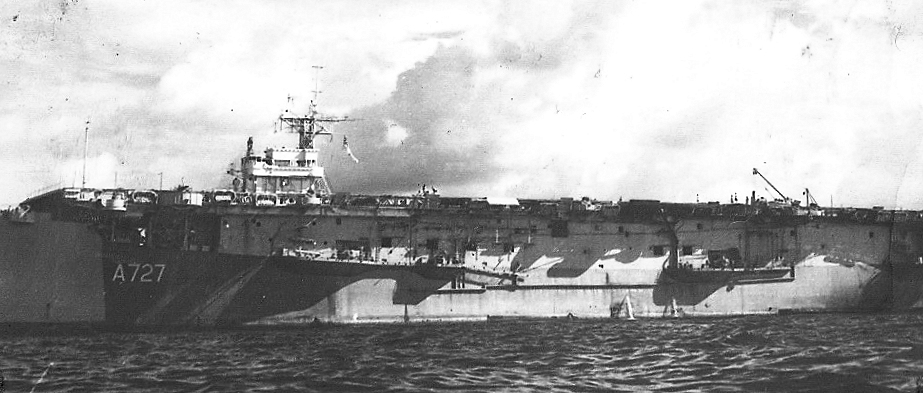 |
HMS CHASER at Sydney. Australia wearing the pennant number R306 which she wore during her service with the British Pacific Fleet during 1945.. Photo courtesy Mr. Paul Silverstone |
Two ferry trips to Hong Kong: December 1945 – February 1946
At some point towards the end of November she sailed for Honk Kong, carrying food and medicine for the Colony, dates unknown. On December 17th 1945 she embarked a single Sea Otter of
1701 squadron from
RNAS Kai Tak (MONAB VIII). This aircraft remained aboard until New Year’s Eve when it was out ashore to Kai Tak and CHASER sailed for Sydney. Here she embarked a second cargo of stores and passengers, sailing for Hong Kong on January 29th 1946.
From Hong Kong her journey is unknown; she is next recorded as being at Surabaya on the Indonesian island of Java in March 1946, possibly on passage to Ceylon and ultimately the UK. There is no record of her arriving in the UK to be paid off; she is next recorded as being returned to the US Navy in May.
Disposal: Return to US Custody
CVE-10 was returned to US Navy custody on May 12th 1946, (presumably at Norfolk Navy Yard) and decommissioned. She was put up for disposal on July 3rd 1946 and struck from the Navy list on 3 August 1946. She was sold to the Waterman Steamship Co., Mobile, Alabama on December 20th 1946 for conversion to a Cargo/Passenger vessel. , and later resold to the United Netherlands Navigation Company on August 27th 1947. Renamed AAGTEKERK (iv) December 4th 1947.
Resold in April 1967 to Chinese Maritime Trust Ltd, Taipeh, and renamed E YUNG. While undergoing repairs to her turbines in the port of Kaohsiung, Taiwan in November 1972 fire broke out. She was towed clear of the harbour and beached still burning. Her crew abandoned her on December 4th, and once burnt out the hull was reflated and moored in Kaohsiung harbour. She was broken for scrap beging on Huly 28th 1973.
Content revised:
20 March 2022
|
Sources used in compiling this account:
Click here for a list of
Primary sources
Additional sources:
Fold3.com various documents including;
Admiralty War Diaries
Norfolk Navy Yard War Diaries
Mew York Navy Yard War Diaries
Miscellaneous documents |
Home
page |
go to the top
|
Comments (1)
I am looking for any information concerning crewlist of HMS Chaser. My grandfather Jack Victor Blight was probably enlisted in this lady and I would like to confirm this information. Thanks for your support. Best regards.